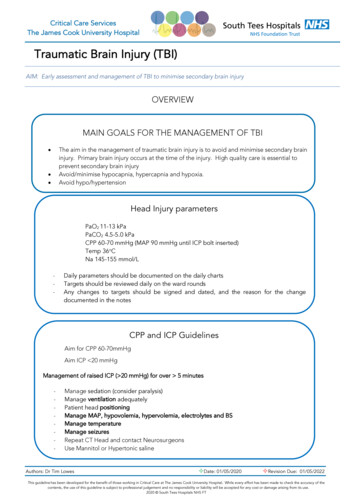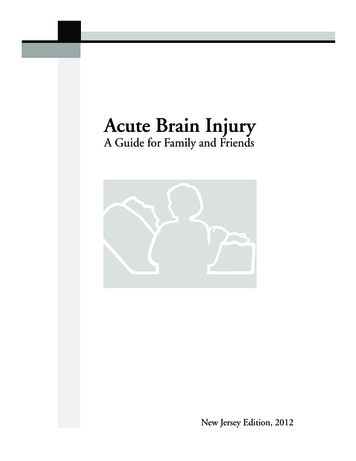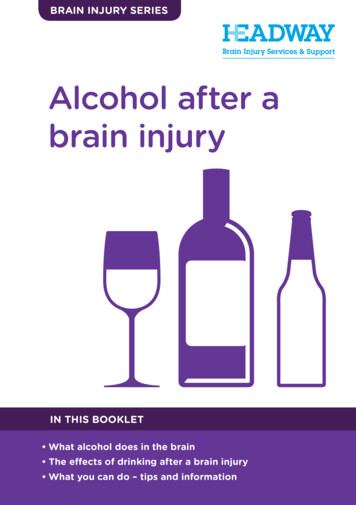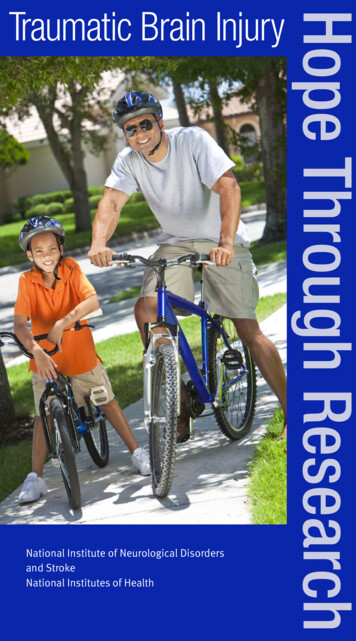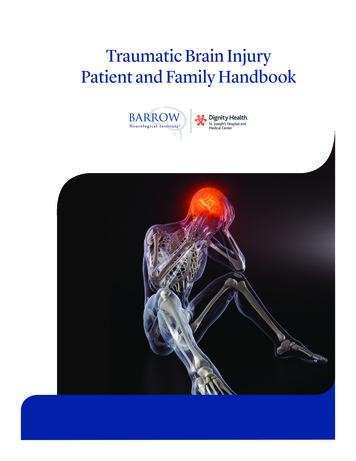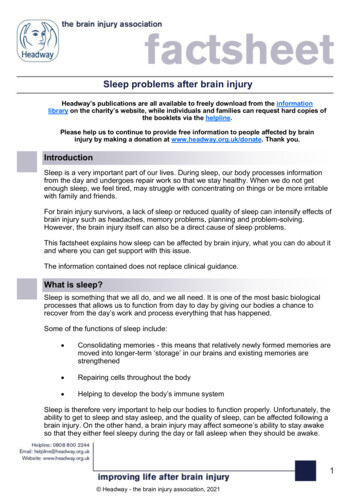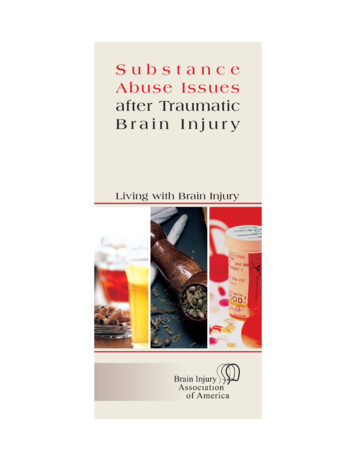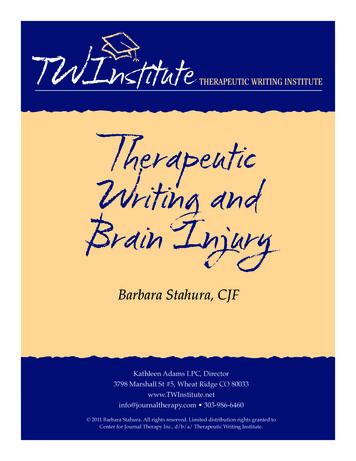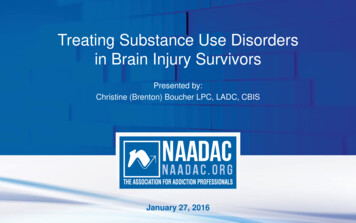
Transcription
Brain InjuryEducation ManualforPatients and FamiliesYou are receiving this education manual because either you or your familymember is at Northeast Rehabilitation Hospital due to an acquired brain injury.An acquired brain injury is any injury to the brain that occurs after birth. This maybe due to a traumatic event (accident, fall), a brain bleed, a brain illness, tumor, orother cause.
Table of ContentsWelcomeProgramWhat is Rehabilitation?Questions and Answers about NRHNTeam MembersIntroduction to Brain InjuryUnderstanding How the Brain WorksBrain Injury StatisticsRancho Los Amigos ScaleHealing the BrainMedical ComplicationsSeizuresFrequently Asked Questions about Brain InjuryCoping with New ChallengesChallenges, Changes, and ChoicesAttention and Brain InjuryCommunication Skills and the Person with Right Brain InjuryCompensation StrategiesDisorientation Following Brain InjuryDriving After a Brain InjuryDsyphagiaDysarthriaFatigue and Brain InjuryHearing Loss and Brain InjuryMemory and Brain InjuryMuscle Tone after a Brain InjuryVisual and/or Perceptual Changes after Brain InjuryVocational RehabilitationBehaviorBehavior DefinitionsFactors Affecting Behavior and CognitionEmotional Changes and Brain InjurySexualitySafetyBrain Injury PreventionHome SafetyPersonal SafetyBrain Injury Recovery ProgramPatient Handbook
Table of ContentsPage 2 of 2Health and WellnessGeneral NutritionExerciseSmoking CessationSubstance AbuseLeisure ActivitiesMedicationsA General Guide for Taking MedicationsMedicationsPreparing for DischargeWhat Happens After Acute CareQuestions to Consider Before DischargeCommunity Connections ClinicsMaking the Most of Visits with Your DoctorRespite CareSelf-AdvocacyResourcesBrain Injury Recovery ProgramPatient Handbook
Thank you for choosingNortheast RehabThe information in this manual was organized by the physicians of New England Neurological Associatesand the Brain Injury staff at Northeast Rehabilitation Hospital. This education manual has been developedto assist you, while your family member is a patient at Northeast Rehabilitation Hospital and as a resource,once they have been discharged from the inpatient Brain Injury Program.While most people are familiar with general hospitals, this may be your first experience with arehabilitation hospital such as Northeast. The differences you may observe reflect the specific goals eachfacility strives to attain. Hospitals are primarily concerned with medical stabilization. They direct theirefforts toward providing a high level of continuous medical care.Rehabilitation centers move a step beyond medical stabilization, utilizing a combination of physical,cognitive, and social therapies to help each patient achieve an optimal level of functioning. In addition to“taking care of “a patient, the rehabilitation plan is designed to satisfy the specific needs of each patient.At Northeast Rehabilitation Hospital, we view the involvement of family and friends as an integral part ofthe treatment process. You may be invited to participate in various therapies. The entire team is availableto meet with you, and in addition, selected team members will meet with you regularly to share informationand review treatment progress. Your input is valuable and is always welcomed and encouraged. Feel freeto ask any team member your questions and please know that your case manager will be your primary pointof contact and information.You should feel a sense of confidence in knowing your family member is being treated at a CARF(Commission on Accreditation of Rehabilitation Facilities) and Joint Commission accredited hospital.These certifications assure you that the hospital meets the highest national standards established in therehabilitative healthcare industry.John F. Prochilo, CEOAdministratorBrain Injury Recovery ProgramPatient Handbook
What is Rehabilitation?Rehabilitation is an educational and therapeutic process. It involves a range of professionals who will workwith you and your family to learn how to achieve your personal goals, your highest level of independencesafely, and help you participate meaningfully in your community.You and your family members are central to the rehabilitation process. Together with your rehabilitationteam, we will make informed decisions about appropriate rehabilitation services and care for you.The effects of a brain injury are usually very different for each individual. An injury to the brain may affectthe person’s abilities to pay attention and remember, to communicate, to undertake everyday tasks, theirpersonality, behavior and mood. And these changes in turn may have implications for the person’s abilitiesto live independently, to communicate effectively with others, drive a vehicle, use public transport, return towork or education, participate in leisure and social activities, perform family roles and maintain personaland family relationships. Some people living with a brain injury may need to acquire new skills anddevelop strategies to compensate and manage their changed ability.Your brain injury rehabilitation team provides the expertise necessary to help you achieve the best possibleoutcomes from your rehabilitation.Where will my rehabilitation occur?Your rehabilitation will occur throughout the hospital including your room and designated therapy areas (i.e.therapy gym). Your rehabilitation program may also include activities such as outings in the communityand education classes for both you and your family.What Types of Rehabilitation Services could I receive?The Brain Injury Inpatient program provides 24-hour, seven-day-a-week medical, rehabilitation and nursingcare.Following your admission to the program, the interdisciplinary team, in partnership with you and yourfamily/caregivers will develop a rehabilitation plan that addresses your identified needs. As part of thisprocess, they will set realistic and achievable rehabilitation goals, so you are able to achieve your best levelof functional independence, social participation and community reintegration.Examples of types of rehabilitation services that may be offered in your program to meet your identifiedneeds and goals could include: Activities of daily living assessment andmanagement Behavioral assessment and management Adaptive/assistive technology/equipmentassessment and training Cognitive assessment and management Audiology (i.e. hearing) screeningBrain Injury Recovery Program Clinical neuropsychological assessment Communication assessment andmanagementPatient Handbook
What is Rehabilitation?Page 2 of 2 Coping and adjustment to disability Patient advocacy service Discharge planning Patient education, training and counseling Driving and community transportassessments Pharmaceutical care and management Dysphagia (i.e. difficulties in swallowing)assessment and management Radiology Family/caregiver education, training andcounseling Podiatry Rehabilitation nursing Respiratory therapy Medical assessment and management Safety awareness and training Mobility assessment and management Smoking cessation Nutritional counseling and management Urology service Orthopedic assessment Visual assessment and management Splinting Vocational consultation and guidance asneeded Pastoral and spiritual servicesDepending on the type of service and your specific needs, some of the services listed above may occur inindividual and/or group training sessions.Furthermore, please note that not every patient will receive all or the same services listed above. Theservices you will receive depend on your individual needs and goals.Rehabilitation is a lifelong process. The ability to carry over the new skills learned in your rehabilitationprogram into your daily activities both at your home and NRH is central to the success of your program.Other services we can provide to meet your needs could include: Information and referral about other services Opportunities for you to meet other people with similar challenges Information and links to community resources and support servicesBrain Injury Recovery ProgramPatient Handbook
Questions and Answers about Brain InjuryRehabilitation at Northeast RehabWhen can we visit?Family members and or visitors that will be involved with care of the patient when they are discharged areencouraged to attend as many therapy sessions as possible with the patient. This will facilitatecommunication between the therapists and the caregivers. This will also allow the caregivers to see what thepatient is or is not capable of doing. If a therapist feels that they need some time alone with the patient, theywill communicate that. Visiting hours for visitors that will not be involved with the care of the patient are11:30am to 8:30 pm.When can phone calls be made and to where?Patients cannot make or receive phone calls after 10 pm at night unless it is an emergency or if nursing feelsit is necessary. Local calls are free from the room but patients will need a calling card for any long distancecalls. Nursing will assist the patient if needed.What volume should the TV or radio be played at?In order to be considerate of others, they must be played at normal volume. Headphones will be provided ifnecessary.What should we bring in from home?Loose fitting clothing that the patient would be comfortable in when working out in the gym. We alsoencourage family members to bring in familiar objects/photos from home. You may also be asked to fill outa biographical questionnaire on the patient so that the team may get to know them better.How do we arrange for the patient to go out on a pass in the community?Requests for passes when therapy is completed should be identified to the nurse, physician, therapist or casemanager several days in advance of the request date with knowledge that special instructions regarding(diet, transfers to and from chair, car, toileting etc.) may need to be given to the family member who will betaking the patient out. Passes can be very therapeutic for the patient but we do ask that they take place whenit will not interfere with the therapy schedule.Can I bring small children onto the unit?Yes as long as there is one adult who is prepared to supervise and/or remove the child if necessary.Should we bring in medications from home?Bringing in medications is not necessary. Occasionally the patient may be on a medication that ourpharmacy does not carry, in that case the medication from home should be given to the nurse and they willensure the correct administration.Brain Injury Recovery ProgramPatient Handbook
Questions and AnswersPage 2 of 2Can I walk the patient or transfer them when they are in their room?Please do not attempt to transfer or walk with a patient unless you have received instruction from ourtherapists. This will ensure the safety of the patient as well as yourself.How should I speak to a person after a brain injury?Speak in your normal tone of voice. , speak slowly and calmly and allow the patient enough time tounderstand what you are saying and to respond. A lot of how you speak to the person depends on theirspecific injury. Always feel free to ask the therapist, nurse or any member of the team the best way toapproach the patient.What should I do when the patient is agitated?Try to identify the cause and redirect the patient’s attention. Don’t ignore or leave the patient alone, speakin a soothing tone of voice. Ask any member of the team for help when necessary.How should I treat the person after a brain injury?Show the person you love and support them. Do not discuss the patient as if they were not there whenspeaking with others even if you think they cannot understand you. Don’t scold them for an incorrectanswer, but do praise them for accomplishments. Remember that the person may not have the same energylevel or endurance as before. Rest periods are important.What is a guardian and does the patient need one?A person may need a temporary guardian when their injury has impacted their ability to make health orfinancial decisions. If the patient has already designated a health care proxy or power of attorney theguardianship will not be necessary. Anyone who is interested in the welfare of the patient may petition theprobate court in their county for temporary guardianship. The doctor, the therapists, and the case managercan help with the decision if a temporary guardian is needed.Where can I get more Community resources?The Massachusetts Brain Injury Association and the New Hampshire Brain Injury Association are excellentresources once the patient is back in the community. The case manager can make an appointment for thepatient and family with these local agencies prior to discharge.Brain Injury Recovery ProgramPatient Handbook
Team MembersDoctorsEvery patient is assigned a primary physician who guides the medical plan of care throughout their stay.The doctors, with the assistance of the rehabilitation team, assess the patients medical status and needs whileat Northeast Rehab.Rehabilitation NursesEvery patient is assigned a primary nurse and a licensed nursing assistant. The Nursing Team checkspatients vitals (temperature, blood pressure, heart and breathing rate), administers medications and helpswith daily care such as eating and bathing. They are continuously evaluating the patient's physical, mentaland medical response to interventions utilized.Family and FriendsYou provide the emotional support to the patient. Family and friends also provide the health care team withimportant facts about the patients past history and can help watch for changes. Team members will showyou what you can do to help with the recovery process.Case ManagersThey provide emotional support to help the patient and the family adjust to being in the hospital. The casemanagers coordinate discharge planning, referral to community resources, and answer questions aboutinsurance or disability. They relay information from weekly team meetings and facilitate communicationbetween team members, the patient, and family as needed.Physical Therapists (PT)Physical therapists help the patient work toward maximizing their independence and quality of life byfocusing on physical mobility training. Treatment may include range of motion/flexibility of the legs,strengthening or muscle re-education, balance, walking/gait training, stair climbing, transfer training, bedmobility training, education and if necessary instruction in the use of equipment such as walkers, canes, orwheelchairs.Occupational Therapists (OT)Occupational therapists help the patient work toward maximizing their independence and quality of life byfocusing on Activities of Daily Living (ADL), that is, functional activities that the person performs everyday. OT activities may include bathing, dressing, grooming, toileting, feeding, sexuality education,functional transfers, functional communication (writing, typing, using the phone etc.) and homemanagement.Therapeutic Recreation (TR)Therapeutic recreation assists the patient with the resumption of a satisfactory, healthy lifestyle through theuse of leisure activities. The focus of TR is leisure skill development/re-development, education onBrain Injury Recovery ProgramPatient Handbook
Team MembersPage 2 of 2adaptive recreation equipment and techniques, and community integration through structured out trips. Theyalso offer peer visitation to assist with the adjustment issues associated with a newly acquired disability.Speech and Language Pathologists (SLP)Speech Language Pathologists (SLP) provide evaluation and treatment for patients experiencingcommunication, cognitive, or swallowing difficulties following a stroke or other neurological dysfunction.Speech Therapy activities may focus on understanding what is said, speaking clearly and meaningfully,assessment and treatment of swallowing difficulties and assessment and treatment of cognitive difficulties,such as memory or concentrationDieticiansDieticians assess nutritional needs of the patients. They work with the patient and other team members tohelp the patients meet their nutritional goals. The dieticians work closely with the patients to educate themabout their dietary requirements, not only while in the hospital, but also for when they go home.PsychologistThe psychologist specializes in evaluating and treating issues involving general coping or adjustment todisability. In addition to offering counseling for problems such as depressed or anxious mood, thepsychologist can provide training in self-help techniques to help manage problems such as pain, insomnia,overeating, smoking and substance abuse. Training in relaxation techniques is especially helpful for many ofthese problems, and can often be learned in just one or two sessions. Lastly, the psychologist can also workclosely with other team members to develop a plan to minimize any psychological "obstacles" to youroverall progress.NeuropsychologistThe role of the neuropsychologist is to provide a detailed evaluation of specific mental abilities such asmemory, attention or learning. It is sometimes quite important to evaluate these areas, as difficulties couldinterfere with your ability to process all the information that comes your way in rehab. Neuropsychologicaldifficulties are not uncommon among persons with neurological illness or injury. If deficits are found, theremay be treatments available to help improve your functioning in these areas. Furthermore, if your team isaware of any neuropsychological difficulties, they can present new information to you in a way that bestmatches your areas of mental strength.Some other team members may includeRespiratory therapyAudiologistInternistPsychiatristCertified Prosthetist/ OrthotistChaplainBrain Injury Recovery ProgramPatient Handbook
Understanding Howthe Brain WorksThe human brain is a complex organ. It weighs only three pounds but is estimated to have about 100 billioncells. It controls all of our physical movements and sensations as well as our ability to think, act, feel andcommunicate.The brain is divided into several parts, each with very specific functions. Normally, the brain manages toperform routine actions regularly and quickly through constant communication between one part of thebrain and the next. When the brain is injured, communication between the different areas of the brain canbecome disrupted. Certain types of problems are commonly seen with injury to specific parts of the brain.In fact, in some cases the areas of the brain that have been damaged can be identified by changes in theindividual’s behavior following injury. The best way to understand the deficits associated with brain injuryis to understand the function of each area of the brain and its related systems and structures.The brain is an electrical and chemical machineLet's start looking at the building blocks of the brain – the cells. Most of these cells are calledneurons. A neuron is basically an on/off switch just likethe one you use to control the lights in your home. It iseither in a resting state (off) or it is shooting an electricalimpulse down a wire (on). It has a cell body, a long littlewire (the "wire" is called an axon), and at the very end ithas a little part that shoots out a chemical. This chemicalgoes across a gap (synapse) where it triggers anotherneuron to send a message. There are a lot of theseneurons sending messages down a wire (axon). Doctorshave learned that measuring this electrical activity cantell how the brain is working. A device that measureselectrical activity in the brain is called an EEG(electroencephalograph). Each of the billions of neurons "spit out" chemicals that trigger other neurons.Different neurons use different types of chemicals. These chemicals are called "transmitters" and are givennames like epinephrine, norepinephrine, or dopamineGetting information in and out of the brainHow does information come into the brain? A lot of information comes in through the spinal cord atthe base of the brain. Think of a spinal cord as a thick phone cable with thousands of phone lines. If youcut that spinal cord, you won't be able to move or feel anything in your body. Information goes OUT fromthe brain to make body parts (arms and legs) do their job. There is also a great deal of INCOMINGinformation (hot, cold, pain, joint sensation, etc.) coming through the spinal cord. Vision and hearing do notgo through the spinal cord but go directly into the brain.Brain Injury Recovery ProgramPatient Handbook
Understanding How the Brain WorksPage 2 of 10Brain anatomy & functionHere are some of the basic structures:SKULL :The bones that come together to cover and protect the brain.SPINAL CORD: A delicate structure about ½” in diameter which starts at the base of the brain andruns down through a tunnel in the backbone. The spinal cord contains a lot of thecircuitry that is responsible for posture, patterns of movement and sensation comingfrom the surface and inside of the body.BRAIN STEM:A small, but complex structure at the base of the brain, resting against the bottom of theskull. All incoming sensory information and all outgoing information to controlmovement comes through the brain stem. The center for control of sleep andwakefulness is located at the top center of the structure. Eye movement, swallowing,coordination of the muscles controlling speech, balance and many basic body functionsare controlled by the brain stem. Certain postural controls and reflexes come from thebrain stem as well.CEREBELLUM:This structure attaches to the back of the stem. Itparticipates in the control of arm and leg movement,eye movement and balance. The cerebellum, locatedbehind the brain stem, is responsible for musclecoordination and balance.VENTRICLES:Watery spinal fluid is produced in cavities within thebrain. Normally, this fluid flows out of the brainthrough tiny holes in the brain stem. It then fills thespace separating the brain and spinal cord from theirhard, bony containers. It is constantly being absorbedby little vessels on the inside of the top of the skull.If anything (for example, blood) blocks usualcirculation or absorption of this fluid, then theventricles tend to expand and may exert pressure onthe brain (a condition called hydrocephalus).Brain Injury Recovery ProgramPatient Handbook
Understanding How the Brain WorksCEREBRALCORTEX:Page 3 of 10The cerebral cortex (cerebrum) is what is most commonly thought of as “the brain”. Itis divided into left and right hemispheres. Generally, each hemisphere directs theopposite side of the body (i.e., the left hemisphere directs the right side of the body andvice versa). Cerebral Cortex (gray matter) consists of a thin sheet of nerve cells thatcovers the surface of brain. The bulk of the hemispheres consist of the nerve fibers(whitematter) connecting these cells.LeftRightEach hemisphere is then divided into four lobes that have specific functions:Frontal Lobes: Are particularly vulnerable to trauma and necessary to higher levelthinking, often called “executive” functions. These functions include the ability to focusattention, organize and plan, problem-solve, make good decisions, and showappropriate judgment. Executive functions also play a role in controlling behavior andemotions.The frontal lobe is the biggest and most advanced part of the brain. (It's called thefrontal lobe because it's in the front part of brain.) One job of the frontal lobe isplanning. The frontal lobe is also involved in organizing. For a lot of activities, weneed to do step A, then step B, then step C. We have to do things in order. That's whatthe frontal lobes help us do. When the frontal lobe is injured, there is a breakdown inthe ability to sequence and organize. A common example is people who cook andleave out a step in the sequence. They forget to add an important ingredient or theydon't turn the stove off.Additionally, the frontal lobes also play a very important role in controlling emotions.Deep in the middle of the brain are sections that control emotions. They're veryprimitive emotions that deal with hunger, aggression, and sexual drive. These areassend messages to other parts of the brain to DO SOMETHING. If you're mad, hitsomething or someone. If you're hungry, grab something and eat it. The frontal lobesBrain Injury Recovery ProgramPatient Handbook
Understanding How the Brain WorksPage 4 of 10“manage” emotions. In general, the frontal lobe has a NO or STOP function. If youremotions tell you to punch your boss, it's the frontal lobes that say "STOP or you aregoing to lose your job”.Occipital Lobes: Responsible for aspects of visual function. (color and formperception)Temporal Lobes: Regulates memory function, language information (comprehensionand expression), aspects of emotional processing, and behavior.Limbic System (located inside the temporal lobe): The limbic system is an area ofvital importance to mood and emotional regulation, motivation, attention, and memory.Injury to this system may result in behaviors ranging froma). flat affect (no expression) to aggressivenessb). mild distractibility to the inability to pay attention and,c). slight memory problems to the inability to recall what happened 30 minutes ago.Parietal Lobes: Important in sensation (touch, pressure, temperature, pain),perception, attention and complex aspects of brain processing. Body sensation, bodyand space images, visual perception, and reading.Here is a summary chart of some of the functions each section of the brain controls.Brain & Behavior RelationshipsFrontal LobeInitiationProblem solvingJudgmentInhibition of behaviorPlanning/anticipationSelf-monitoringMotor planningPersonality/emotionsAwareness of nMental flexibilitySpeakingTemporal LobeMemoryHearingExpressive and receptive languageComprehension of languageMusical awarenessOrganization &sequencing skillsBrain Injury Recovery ProgramParietal LobeSense of touchDifferentiation of size, color, shapeSpatial perceptionVisual perceptionOccipital LobeVisual perception (depth) andinputReading (perception andrecognition of printed words)CerebellumCoordinationBalanceSkilled motor activityBrain StemBreathingHeart rateArousal/ConsciousnessSleep/wake functionsAttention/concentrationPatient Handbook
Understanding How the Brain WorksPage 5 of 10MovementThe area of the brain that controls movement is in a very narrowstrip that goes from near the top of the head right down alongwhere your ear is located. It's called the motor strip. If I have astroke in the left hemisphere of my brain, the right side of thebody will stop working. If I have an injury to my righthemisphere in this area, the left side of my body stops working(remember, we have two brains). This is why one half of theface may droop when a person has had a stroke.Hearing and languageIn the general population, 95 percent of people are right-handed, which means that the left hemisphere is thedominant hemisphere. (For you left-handers, the right hemisphere is dominant.) With right-handed people,the ability to understand and express language is in this left temporal lobeThe right temporal lobe also deals with hearing. However, its job is to process musical information or helpin the identification of noises. If this area is damaged, we might not be able to appreciate music or be ableto sing. Because we tend to think and express in terms of language, the left temporal lobe is more criticalfor day-to-day functioning.What is brain injury and what happens to the brain when it is injured?Traumatic brain injury (TBI) refers to damage to the brain caused by an external physical force such as a caraccident, a gunshot wound to the head, or a fall. A TBI is not caused by something internal such as a strokeor tumor, and does not include damage to the brain due to prolonged lack of oxygen (anoxic brain injuries).It is possible to have a TBI and never lose consciousness. For example, someone with a penetrating gunshotwound to the head may not lose consciousness.Types of injuriesThe brain is about 3–4 pounds of extremely delicate soft tissue floating in fluid within the skull. Under theskull there are three layers of membrane that cover and protect the brain. The brain tissue is soft andtherefore can be compressed (squeezed), pulled, and stretched. When there is sudden speeding up andBrain Injury Recovery ProgramPatient Handbook
Understanding How the Brain WorksPage 6 of 10slowing down, such as in a car crash or fall, the brain can move around violently inside the skull, resultingin injury.Closed versus open head injuryClosed means the skull and brain contents have not been penetrated (broken into or through), whereas openmeans the skull and other protective layers are penetrated and exposed to air. A classic example of an openhead injury is a gunshot wound to the head. A classic closed head injury is one that occurs as the result of amotor vehicle crash.In a closed head injury, damage occurs because of a blow to the person’s head or having the head stopsuddenly after moving at high speed. This causes the brain to move forward and back or from side to side,such that it collides with the bony skull around it. This jarring movement bruises brain tissue, damagesaxons (part of the nerve cell), and tears blood vessels. After a closed head injury, damage can occur inspecific brain areas (localized injury) or throughout the brain (diffuse axonal injury).Damage following open head injury tends to be localized and therefore damage tends to be limited to aspecific area of the brain. However, such injuries can be as severe as closed head injuries, depending on thedestructive path of the bullet or other invasive object within the brain.Primary versus secondary injuriesPrimary injuries occur at the time of injury and there is nothing that physicians can do to reverse thoseinjuries. Instead, the goal of the treatment team in the hospital is to prevent
Driving After a Brain Injury . Dsyphagia . Dysarthria . Fatigue and Brain Injury . Hearing Loss and Brain Injury . Memory and Brain Injury . Muscle Tone after a Brain Injury . Visual and/or Perceptual Changes after Brain Injury . Vocational Rehabilitation. Behavior . Behavior Definitions . Factors Affecting Behavior and Cognition. Emotional .
